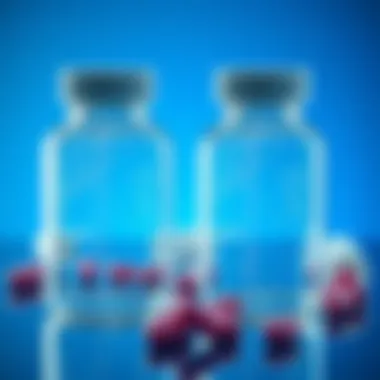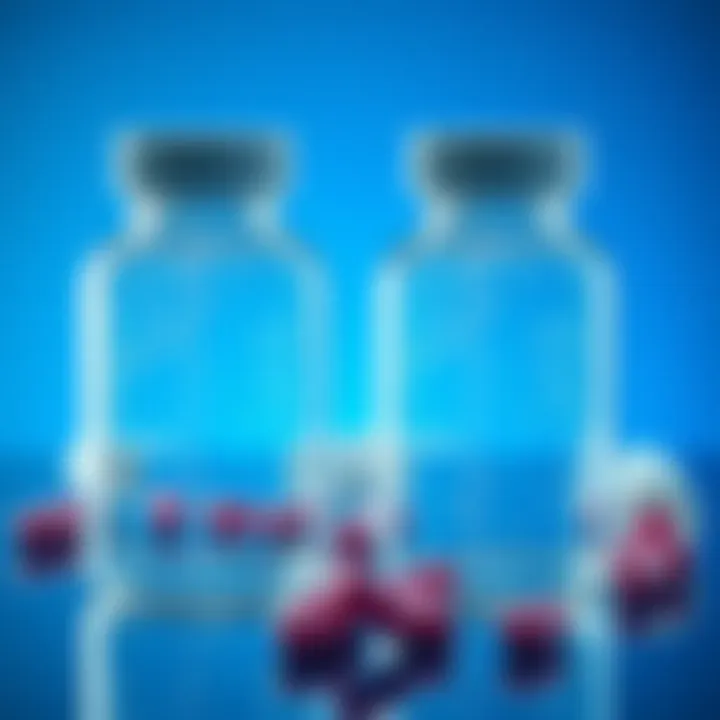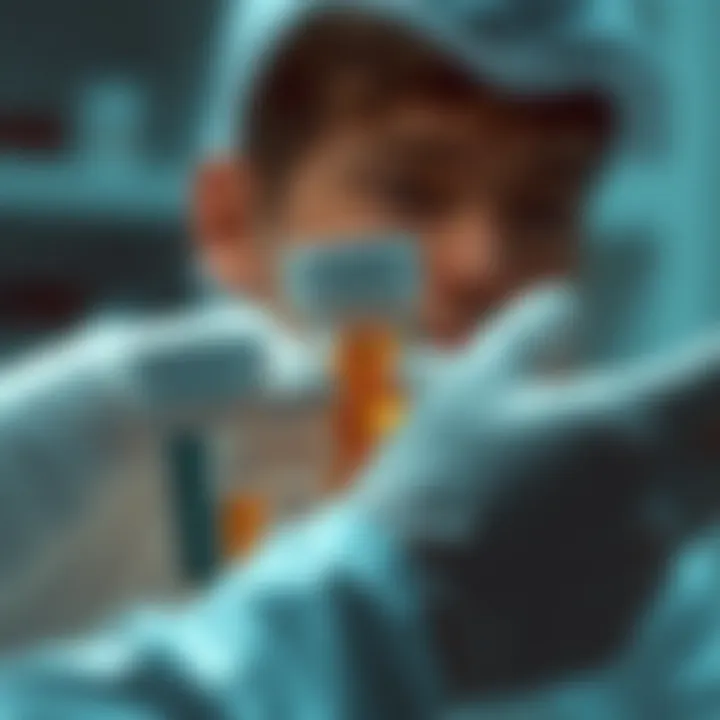Tadalafil vs Sildenafil Citrate: A Detailed Comparison


Intro
Erectile dysfunction (ED) remains a complex and prevalent issue that many individuals experience as they age. Among the myriad of treatments available, tadalafil and sildenafil citrate stand out as the leading medications. Their primary function revolves around enhancing sexual performance by improving blood flow to the penis, but how they accomplish this varies significantly. Understanding these differences is crucial for anyone affected by ED, whether for personal knowledge or for healthcare professionals prescribing these therapies.
This article aims to dissect the experiences of these two medications, examining aspects like their mechanisms, efficacy, and patient suitability.
Research Background
Overview of the Scientific Problem Addressed
Erectile dysfunction can complicate personal relationships and self-esteem. It can stem from various factors, including psychological issues, physical health conditions, and the side effects of certain medications. Despite its prevalence, there’s still a stigma surrounding ED. Thus, many men may hesitate to seek treatment, often remaining in the dark about effective solutions.
Tadalafil and sildenafil citrate offer distinct pathways for relief. Tadalafil acts on the body for a longer duration, while sildenafil has a quicker onset but a shorter duration. Delving into their effectiveness, side effects, and patient experiences demystifies these options, helping individuals make informed decisions about their treatment.
Historical Context and Previous Studies
The development of sildenafil citrate began in the late 1980s when researchers initially sought to address angina, a heart condition. The unexpected discovery of its efficacy in treating ED led to rapid approval by the FDA in 1998. Subsequently, tadalafil entered the scene in 2003, offering a longer duration of action, which appealed to many men looking for flexibility.
With a growing number of studies, including comparative analyses that spotlight the advantages and challenges of each, patients have gained insight into not only which medication might be suitable but also why clinicians choose one over the other.
Findings and Discussion
Key Results of the Research
Research suggests that while both medications are effective, specific outcomes might vary based on person-to-person factors. Sildenafil may start acting within 30 minutes but lasts roughly four to six hours, making it ideal for spontaneous activity. In contrast, tadalafil can last up to 36 hours, allowing for more spontaneous intimacy over a weekend getaway.
Interpretation of the Findings
Understanding the duration and onset is crucial when discussing treatment with patients. A patient who travels frequently may find tadalafil more suitable based on its longevity, while another who desires prompt results might prefer sildenafil.
"The ideal treatment for erectile dysfunction not only depends on the efficacy of the medication but also the individual lifestyle and preferences of the patient."
The conversation surrounding the medications often involves side effects. Common ones like headaches, flushing, and nasal congestion are worth discussing. These side effects do not occur equally across the board, and understanding personal health histories is essential in these conversations.
Preamble to Erectile Dysfunction Treatments
The discussion surrounding erectile dysfunction (ED) is increasingly crucial in today’s healthcare dialogues. Not only does it impact the quality of life for millions of men worldwide, but it also carries emotional and psychological dimensions that ripple through intimate relationships. Understanding this condition is the first step toward addressing it effectively.
Erectile dysfunction, a point of struggle for many, is not simply a matter of physical capability; it's entwined with psychological, relational, and biological factors. Many men feel stigmatized when seeking help, often suffering in silence or resorting to unverified remedies. This article opens the door to understanding two prominent medications: tadalafil and sildenafil citrate. These drugs form the backbone of contemporary pharmacotherapy, providing reliable solutions that many men depend on.
By shedding light on the intricacies of these treatments, we aim to equip readers—be they healthcare professionals, researchers, or patients—with pertinent knowledge that can guide informed therapeutic decisions. Recognizing that every individual may respond differently to treatment options underscores the significance of personalized care. The forthcoming sections delve into the particulars, offering a thorough comparison that highlights efficacy, side effects, and patient experiences. This careful examination is vital as it can greatly influence the path chosen by those grappling with this condition.
Definition and Overview of Erectile Dysfunction
Erectile dysfunction is clinically defined as the recurring inability to achieve or sustain an erection sufficient for satisfactory sexual performance. This condition varies widely; some may experience it intermittently, while others may face ongoing challenges. It’s estimated that nearly 30 million men in the United States alone confront this issue, but the numbers can be even larger when considering those who go undiagnosed.
The impact of ED transcends the physical realm, often intertwining with emotional and psychological struggles such as depression, anxiety, and lowered self-esteem. The complexity of the condition requires an understanding that can bridge both medical and socio-emotional pathways. Factors contributing to ED can be numerous, ranging from chronic health issues like diabetes or heart disease, to lifestyle choices such as smoking or excessive alcohol use.
Key Points:
- Frequency: It’s common; many men will face it, especially as they age.
- Underlying Factors: Physical ailments, mental health, and lifestyle all play roles.
- Importance of Addressing: Tackling this issue can improve overall well-being and relationships.
Role of Pharmacotherapy in Management
Pharmacotherapy plays a pivotal role in addressing ED, offering relief to those affected and improving their quality of life. The introduction of oral medications revolutionized treatment options, moving beyond invasive procedures to simpler, more accessible solutions. Tadalafil and sildenafil citrate have become the most recognized names in this realm, providing men with reliable avenues to achieve erections that sustain sexual activity.
These medications operate by enhancing blood flow to the penis, effectively making it easier to achieve an erection when arousal occurs. However, their efficacy can vary based on individual health, adherence to recommended dosages, and other factors.
Utilizing these medications not only aids in physical response but can also help alleviate the psychological burdens associated with ED, fostering a renewed sense of confidence among users. Coupled with lifestyle changes and potential counseling, pharmacotherapy serves as a cornerstone in the comprehensive management of erectile dysfunction.
"Understanding both the physical and emotional sides of ED is vital in creating a supportive environment for those affected."
Advantages of Pharmacotherapy:
- Accessibility: Easy to obtain with a prescription.
- Non-Invasive: Offers a non-surgical solution.
- Rapid Onset: Many medications work within 30 to 60 minutes.
Pharmacological Profiles of Tadalafil and Sildenafil Citrate


Understanding the pharmacological profiles of tadalafil and sildenafil citrate is crucial for clinicians and patients alike. These medications are at the forefront of treating erectile dysfunction (ED), and the differences in their chemical and functional aspects significantly affect their use in real-world scenarios. Knowing how these drugs work and their respective profiles can help in making informed decisions about which treatment might be more suitable for an individual.
Chemical Composition and Structure
Both tadalafil and sildenafil citrate belong to the class of medications known as phosphodiesterase type 5 (PDE5) inhibitors, but they exhibit unique chemical compositions and structural properties.
- Tadalafil is chemically labeled as 1-(2E)-4-[(1,3-benzodioxol-5-yl)methyl]phenylmethylideneurea. Its structure allows for a longer half-life and sustained effect, making it particularly popular for its once-daily dosing option.
- Sildenafil citrate, on the other hand, is known as 2-ethoxy-5-[4-(2-hydroxyethyl)-1-piperazinyl]carbonyl-1H-benzimidazole-1-ethanol. This structure lends itself to a quicker onset of action, which may be beneficial for spontaneous encounters.
The different chemical frameworks influence not just the efficacy but also the side effect profiles and dosage forms available for each medication. Knowing these details can help understand why one might work better than the other, depending on individual patient needs.
Mechanism of Action
At the heart of how tadalafil and sildenafil citrate operate is their ability to inhibit the PDE5 enzyme, which plays a crucial role in the degradation of cGMP (cyclic guanosine monophosphate). Both medications enhance the effects of nitric oxide, which leads to improved blood flow to the penis during sexual stimulation. However, there are nuanced differences in their actions.
- For tadalafil, the inhibition of PDE5 increases cGMP levels more effectively, which leads to prolonged vasodilation. This underscores why it can provide a longer duration of action, sometimes up to 36 hours in some men. This quality is often referred to as the "weekend pill" phenomenon, allowing for greater spontaneity in sexual activity.
- Sildenafil citrate works similarly by inhibiting PDE5, but its effects are generally shorter-lived. The onset can occur within 30-60 minutes but it typically lasts for about 4 to 6 hours. This can be ideal for men who need a more immediate solution without the extended window of action that tadalafil provides.
"Understanding how tadalafil can sustain its effect for much longer than sildenafil helps patients choose based on their lifestyle and frequency of sexual activity."
These mechanisms outline how their pharmacological actions directly relate to patient experiences. Having this understanding can empower patients and healthcare providers to tailor therapy more appropriately.
Pharmacokinetics Comparison
Understanding pharmacokinetics is crucial when considering the treatment of erectile dysfunction, especially when comparing medications like tadalafil and sildenafil citrate. Pharmacokinetics, which encompasses how the body absorbs, distributes, metabolizes, and excretes drugs, directly influences their efficacy and overall patient experience. Different pharmacokinetic profiles can affect not only how quickly the medications work but also how long their effects last, making this comparison essential for both healthcare providers and patients.
Absorption and Bioavailability
The absorption of a medication refers to how quickly and effectively it enters the bloodstream after administration. Tadalafil and sildenafil citrate exhibit differences in their absorption processes that can influence patient outcomes significantly.
- Tadalafil: After oral ingestion, tadalafil shows relatively high bioavailability, ranging from 80% to 100%. This means that a substantial portion of the active ingredient ultimately reaches the circulation, making it potent in smaller doses. The drug tends to peak in the bloodstream within two hours.
- Sildenafil citrate: Conversely, sildenafil has a bioavailability between 40% and 50%, which means that a lower percentage of the drug enters systemic circulation when taken compared to tadalafil. It typically reaches peak concentrations within one hour post-ingestion. The difference in absorption rates could be a pivotal factor in treatment decisions, especially for patients looking for faster onset of action.
In essence, while both medications are effective, the rapid absorption of sildenafil could cater to those requiring quick relief, while tadalafil's enhanced absorption supports longer-term usage.
Half-Life and Duration of Action
The half-life of a drug is an indicator of how long it stays active in the body before it’s reduced by half its initial concentration. This metric is significant for determining dosing schedules and effective management of erectile dysfunction.
- Tadalafil: The half-life of tadalafil is around 17.5 hours, offering a notable advantage when compared to sildenafil. This extended duration allows tadalafil to remain effective for up to 36 hours, which is often referred to as the
Efficacy in Treating Erectile Dysfunction
Efficacy in treating erectile dysfunction (ED) plays a pivotal role in understanding how well tadalafil and sildenafil citrate operate. Both medications aim to improve the sexual health of individuals, but they do so in ways that impact various aspects of usage, patient satisfaction, and overall health outcomes. Unpacking these elements gives clarity on not only the effectiveness of these drugs but also informs patients and clinicians about making the right choices tailored to individual needs.
Clinical Trials and Evidence-Based Outcomes
A strong foundation of clinical trials underpins the efficacy of tadalafil and sildenafil citrate. Studies have consistently demonstrated that both medications significantly enhance the ability to achieve and maintain an erection sufficient for sexual activity. Researchers conducted double-blind, placebo-controlled trials to ensure reliability in outcomes.
For instance, one pivotal study involving sildenafil citrate showed that approximately 83% of men who took the drug reported successful erections, compared to just 35% of those on a placebo. Meanwhile, tadalafil has also shown remarkable results; it was reported that around 75% of patients experienced improved erectile function, significantly enhancing their sexual life compared to a negligible percentage in the placebo group.
The following points summarize key findings from trials focusing on effiicacy:
- Dosage Variety: Tadalafil offers flexibility with its daily low-dose option, making it appealing for those who prefer spontaneous sexual experiences. Clinical evidence supports that this approach encourages use and increases satisfaction levels.
- Onset Timing: Sildenafil typically works quickly, with effects noticeable within 30-60 minutes, while tadalafil may take about 2 hours but boasts a much longer duration—up to 36 hours. This difference might lead one to prefer tadalafil for planned events.
- Target Populations: Studies frequently distinguish between different populations—such as older adults and those with underlying health conditions—ensuring that efficacy remains robust across diverse demographics.
The wealth of available evidence helps delineate how practitioners can best utilize these drugs in various patient scenarios, effectively enhancing their quality of life.
Patient Satisfaction and Preference Studies
When it comes to treatment, patient satisfaction cannot be overlooked. Preferences between tadalafil and sildenafil arise from not only clinical efficacy but also individual experiences regarding comfort and convenience.
Surveys often indicate that many patients prefer tadalafil, primarily due to its prolonged action. Here’s what recent preference studies have revealed:
- Ease of Use: Many report that being able to take tadalafil as a daily regimen suits their lifestyles better. It provides a sense of normalcy without the pressure of timing doses, often leading to enhanced satisfaction in sexual spontaneity.
- Side Effect Management: Preferences also link to side effects experienced with each medication, as some individuals may tolerate one drug better than the other. Overall satisfaction scores often tip in favor of tadalafil when considering long-term usage and minimal side effects.
- Psychosocial Factors: Various studies have documented that individuals feel more in control of their sexual health when they have the option of longer-lasting effects, thus augmenting their confidence and intimate relationships.
“The true success of any ED treatment lies beyond performance metrics; it encompasses the patient's emotional and relational well-being.”
In summation, the insights derived from clinical trials coupled with patient preference surveys illustrate a comprehensive picture of efficacy in treating erectile dysfunction with both tadalafil and sildenafil citrate. Understanding these aspects equips healthcare professionals and patients alike to make informed, suitable choices that go beyond mere statistics, as they have real impacts on lives and relationships.
Side Effects and Contraindications
Understanding side effects and contraindications is crucial when discussing medications for erectile dysfunction, such as tadalafil and sildenafil citrate. These elements not only affect the treatment's effectiveness but also impact patient safety and overall satisfaction. Knowing the potential downsides helps both patients and healthcare providers make informed decisions tailored to the individual’s health needs. It's like navigating a minefield; one wrong step could lead to unwanted consequences.


Common Side Effects of Tadalafil
Tadalafil is often favored for its prolonged duration of action, but it comes with its own set of side effects that users should be aware of. Some of the more common issues include:
- Headaches: These can be quite persistent and may affect daily activities.
- Indigestion: Gastrointestinal discomfort may arise, particularly in those with previous gastrointestinal issues.
- Back Pain: Users report varying degrees of discomfort in the lumbar region.
- Muscle Aches: Some have also described generalized muscle pain, which can be bothersome.
- Flushing: Many experience warmth or redness in the face and neck.
While these side effects are typically mild to moderate, it’s key to monitor them, especially when starting the medication. Report any severe or ongoing symptoms to a healthcare professional.
Common Side Effects of Sildenafil Citrate
On the other hand, sildenafil citrate has its own profile of potential side effects. Some common ones are:
- Visual Disturbances: Users sometimes notice changes in color perception or increased sensitivity to light.
- Nasal Congestion: A feeling of congestion or a runny nose can be a hindering side effect.
- Headaches: Much like tadalafil, headaches are frequently reported.
- Dizziness: Some individuals experience lightheadedness, which can impair activities.
- Flushing: Similar to tadalafil, flushing may also occur.
Those side effects can also vary from person to person, emphasizing the need for open dialogue with a healthcare provider.
Comparative Analysis of Safety Profiles
When comparing the safety profiles of tadalafil and sildenafil citrate, one must consider both common and rare side effects along with each drug's contraindications. Both medications should not be used in conjunction with nitrates due to the risk of causing a severe decrease in blood pressure.
Key Points in Comparative Safety:
- Tadalafil tends to have a longer half-life, implying that the side effects may persist longer compared to sildenafil.
- Sildenafil, while effective, may lead to more pronounced visual disturbances, a factor that's crucial for patients requiring visual acuity in daily tasks.
Although they have overlapping side effects, their unique profiles allow healthcare professionals to choose a medication based on the patient’s specific health concerns, preferences, and lifestyle. Monitoring for adverse effects is always recommended, and patients should feel empowered to seek guidance when side effects occur.
"Knowledge of potential side effects is your best defense against unexpected issues."
For patients, being informed goes a long way in successfully managing treatment and enhancing quality of life. This understanding helps bridge the gap between patient expectations and medical reality, fostering a collaborative approach in managing erectile dysfunction.
Drug Interactions and Precautions
Understanding the interactions and precautions related to tadalafil and sildenafil citrate is crucial for safe and effective use. Both medications have the potential to interact with other substances, which can modify their effects or lead to unforeseen complications. Patients and healthcare professionals must be vigilant about these interactions to optimize treatment outcomes while minimizing risks.
Interactions with Nitrates
Tadalafil and sildenafil citrate can significantly interact with nitrates, a class of medications often prescribed for angina and other heart-related conditions. The combination of these ED medications with nitrates can lead to a severe drop in blood pressure. This potentially dangerous scenario can result in dizziness, fainting, or even more severe cardiovascular events.
It's important to note:
- Nitrates include: nitroglycerin, isosorbide dinitrate, and isosorbide mononitrate.
- Mechanism of Interaction: Both tadalafil and sildenafil work by inhibiting the enzyme phosphodiesterase type 5 (PDE5), which increases levels of cyclic GMP, leading to vasodilation. When combined with nitrates, vasodilation is further amplified, posing substantial risks.
- Recommendations: Patients currently on nitrates should never take tadalafil or sildenafil without precise medical advice. This reinforces the need for a thorough medication review by healthcare providers.
"It's essential to inform your doctor of all medications you are taking, particularly if they include nitrates, to avoid serious consequences."
Alcohol and Other Substances
Alcohol consumption can also alter the effects of tadalafil and sildenafil citrate. While moderate drinking may not pose serious issues, excessive alcohol intake can impede the effectiveness of these medications.
Key points about alcohol interactions include:
- Potential Negative Effects: High alcohol intake can lead to decreased libido, impaired ability to achieve an erection, and can amplify the side effects of ED medications, such as flushing, headaches, or dizziness.
- Use with Caution: Patients are generally advised to limit alcohol consumption on days they plan to use tadalafil or sildenafil. This ensures that the medications will work effectively without excessive side effects.
- Interactions with Other Substances: Some recreational drugs, such as amyl nitrite (often misused as "poppers"), can pose similar risks to those associated with nitrates. This could lead to dangerous drops in blood pressure as discussed previously.
In summary, caution is key when considering tadalafil and sildenafil citrate in conjunction with other substances. Proper patient education and a comprehensive medication review can help in mitigating risks associated with drug interactions and enhance overall treatment efficacy.
Availability and Cost Considerations
The discussion surrounding tadalafil and sildenafil citrate should inevitably touch on availability and cost considerations. These elements are crucial for both healthcare providers and patients, as they significantly influence the choice of medication and adherence to treatment. Accessibility to these medications is not just about being able to acquire them; it is also about navigating insurance hurdles, understanding generics versus brand names, and recognizing regional differences in pricing.
Understanding the landscape of how easily these drugs can be obtained and at what cost can drastically alter a patient's experience with erectile dysfunction treatment. In some cases, a potential barrier might exist—not just due to financial implications but also regarding the stigma tied to purchasing medications related to sexual health.
Prescription and Over-the-Counter Options
When discussing the cvs of treatments for erectile dysfunction, it’s important to highlight the availability through both prescriptions and over-the-counter options. In recent years, the market for erectile dysfunction medications has seen changes aimed at enhancing patient access. For instance, both tadalafil, marketed under the name Cialis, and sildenafil citrate, known as Viagra, traditionally required a doctor’s prescription. This means patients had to engage in a dialogue with their healthcare providers, which could sometimes feel daunting or embarrassing.
However, there’s been a push towards increasing access. For example, some pharmacies now offer sildenafil citrate without a prescription, thanks to supportive guidelines that have emerged from various health organizations. Patients can walk in, discuss their concerns, and potentially acquire the medication in a more discreet manner. On the flip side, tadalafil is still largely prescription-only, though telehealth options have opened new avenues for access. In both cases, understanding local regulations and healthcare policies is imperative.
Additionally, generics have entered the fray. Generic versions of sildenafil are available in many markets, often at a fraction of the cost of the branded Viagra. This competitive landscape helps to alleviate financial burdens and encourages treatment adherence, which, in turn, benefits patients’ overall quality of life.


Cost Analysis in Different Markets
Diving into the cost aspect, it varies quite significantly across different markets. For instance, in the United States, the price for a single pill of branded Viagra can hover around $65 to $80 without insurance coverage. In contrast, its generic counterparts can be found for as low as $30 for a similar dosage. On the other hand, tadalafil may be priced slightly higher navigating into the $80 range per pill for the branded version. However, generic tadalafil options are similarly available, bringing the cost down.
When assessing costs regionally, we see notable differences in other countries, such as Canada or the UK, where patented medications might face different regulations allowing for lower prices.
- United States:
- Canada:
- Brand Viagra: $65 - $80/pill
- Generic Sildenafil: ~$30/pill
- Brand Cialis: ~$80/pill
- Generic Tadalafil: comparable pricing to sildenafil
- Prices typically lower due to price regulations on patented drugs
Understanding where to access these drugs can be a minefield, especially if a patient is trying to do so discreetly. A smart consumer would do well to shop around, checking with local pharmacies, online pharmacies, and even some prescription discount cards. Websites like GoodRx can help customers compare prices across various local pharmacies.
Ultimately, this arena is about striking the right balance between availability and cost, ensuring patients receive the medications they need without breaking the bank.
Patient-Centered Factors in Medication Choice
Choosing the right medication for treating erectile dysfunction goes beyond simple pharmacological properties. A patient-centered approach brings into focus not just the drug's effectiveness, but a myriad of factors which influence individual experiences and outcomes. Understanding these factors is particularly vital as it helps tailor treatment to fit each patient's unique situation. This involves considering their age, health status, lifestyle choices, and psychological wellbeing.
In a landscape cluttered with options, the importance of individual-centered factors—often overlooked—cannot be emphasized enough. Properly addressing these elements enhances treatment compliance, satisfaction, and overall results.
Age and Health Status Considerations
Age and the overall health status of a patient weigh heavily on choosing between tadalafil and sildenafil citrate. Generally, older adults might face different physical conditions like diabetes or cardiovascular disease that can complicate erectile dysfunction management.
- Age Factor:
- Health Influences:
- Older patients often have a slower metabolism which can affect how medications are absorbed and processed.
- For instance, tadalafil's longer half-life may be more suitable as it offers flexibility with its dosing schedule. Senior patients may find it hard to strictly adhere to a medication schedule, so a once-daily option like tadalafil could simplify things.
- Patients with underlying health issues like hypertension or heart disease must be cautious. Sildenafil can have more contraindications with certain heart medications compared to tadalafil. Safety is paramount; hence, a thorough evaluation is crucial.
"Understanding an individual's health profile is key to ensuring safe and effective treatment options. The wrong choice could lead to adverse effects and risks."
Thus, engaging patients in discussions that are open and informative about their health can significantly impact their choice of medication. It is also pivotal for practitioners to create a supportive environment where concerns about age and health are thoroughly addressed.
Psychosocial Factors
Psychosocial elements play a crucial role in how patients perceive and respond to treatment for erectile dysfunction. Mental health, relationship dynamics, and personal expectations can influence treatment outcomes just as much as the physical aspects of medications.
- Mental Health Status:
- Social Dynamics:
- Expectations and Self-Esteem:
- Anxiety and depression are often associated with erectile dysfunction. The stress of performance can be daunting. Medications might help address the physical issue, but if the mental health angle isn't looked after, the medication alone may not make a significant difference.
- The patient's relationship status and history can greatly affect their sexual experience. For instance, someone who feels secure and has open communication with their partner may respond better to medications than someone in a strained relationship.
- Patient expectations about the effectiveness of the medication can influence adherence and satisfaction levels. High expectations can lead to disappointment when the results don't meet their hopes. It’s essential for doctors to manage these expectations calmly and constructively.
Taking all these psychosocial factors into consideration can lead to a more holistic and effective treatment plan. The dialogue between patients and healthcare providers must be ongoing, ensuring both sides understand the unique challenges and desires involved.
In summary, a patient-centered approach that considers age, health, and mental well-being boosts the likelihood of successful erectile dysfunction treatment. Engaging patients in the discussion of their treatment options fosters an environment where all factors are acknowledged and respected, ultimately leading to better health outcomes.
Closure and Future Directions
In the realm of erectile dysfunction treatments, tadalafil and sildenafil citrate stand out as two significant options. Their differences in efficacy, duration, and patient-centered factors prompt essential considerations for both healthcare providers and patients. This comprehensive comparison not only sheds light on the key attributes of these medications but also illustrates their potential impact on individual treatment pathways.
When discussing the summary of findings from our exploration, it becomes clear that while both drugs serve the same purpose, they do so with nuanced differences. For instance, tadalafil, often noted for its longer lasting effect, can allow for more spontaneity in sexual encounters, which is a pivotal factor for many users. In contrast, sildenafil serves as a more immediate solution, with a faster onset of action. Each choice carries its own set of advantages and drawbacks that cater to specific needs and lifestyles.
Both medicines have shown strong efficacy in restoring erectile function, yet patient preference heavily influences the choice between tadalafil and sildenafil.
Summation of Key Findings
The key findings of this article highlight the following points:
- Mechanism of Action: Both drugs work as phosphodiesterase type 5 (PDE5) inhibitors, but their duration and timing of action differ.
- Pharmacokinetics: While sildenafil has a shorter half-life, tadalafil offers longer-lasting effects, making daily dosing an option for some individuals.
- Side Effects: Common adverse effects for both medications include headaches and flushing, although the incidence rate can vary.
- Patient Satisfaction: Studies indicate a preference for tadalafil among users seeking longer-lasting effects, while sildenafil remains favored by those valuing rapid onset.
This in-depth look confirms the importance of tailoring treatment plans to the individual patient, rather than a one-size-fits-all approach.
Future Research Areas
As we gaze into the future of erectile dysfunction treatments, several key research areas beckon:
- Personalized Medicine: Investigating how genetic factors influence individual response to tadalafil and sildenafil could refine prescription practices.
- Long-Term Effects: Additional studies examining the long-term efficacy and safety profiles of both medications will be crucial as they become established in treatment regimens.
- Emerging Therapies: Exploring new pharmacological agents or combination therapies could expand the arsenal against erectile dysfunction, offering wider options beyond current PDE5 inhibitors.
- Patient Perspectives: Qualitative research assessing patient experiences and satisfaction with treatment can further inform prescribing choices.
As knowledge of erectile dysfunction continues to evolve, future studies will play a pivotal role in enhancing therapeutic strategies, ensuring that patients receive optimal care tailored to their unique situations.







